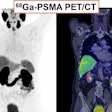Dear AuntMinnie Member,
The opening of RSNA 2016 is still several days away, but we're pleased to bring you a first look at some of the fascinating presentations to be highlighted at radiology's premier conference.
For example, Brazilian researchers will demonstrate how they created 3D models from data acquired with imaging scans, and then used virtual reality devices to view the images. They believe the technique has clinical utility while also serving as a tool to help parents bond with their unborn children. Learn more by clicking here.
In another talk to be presented in Chicago, researchers from Massachusetts General Hospital used a high-resolution peripheral quantitative CT scanner to calculate bone mineral density and bone architecture in teenagers. They found that subjects who were obese had a higher risk of permanent bone loss. That story is available by clicking here.
Also learn about a research study that's being conducted in McCormick Place on just what's going on when radiologists are interpreting images. Learn more by clicking here.
We'll be highlighting more stories from RSNA 2016 over the next few days; our daily coverage begins on November 27, so be sure to check out our RADCast @ RSNA at rsna.auntminnie.com for all the news.
Chest x-ray for syncope
Radiography is a great first-line imaging tool for a number of conditions. But is syncope one of them?
Researchers from Harvard Medical School and Beth Israel Deaconess Medical Center in Boston wanted to find out if it was worthwhile to perform chest x-rays on patients admitted to the emergency department with syncope. Such exams could help identify cases in which more serious pathology was causing the problem, but the potential downside is the large number of studies that would have to be performed for every positive case.
In the study, the researchers found that chest x-rays probably were useful for this indication. Read more by clicking here, or visit our Digital X-Ray Community at xray.auntminnie.com.
Macrocyclic gadolinium contrast
We're beginning to learn more about the etiology of gadolinium deposition in the brains of individuals who have received gadolinium-based contrast agents for MRI exams. One of the main points is that macrocyclic gadolinium agents seem to result in lower levels of residual gadolinium compared to linear agents, which was confirmed by a new study we're highlighting in our MRI Community. Check it out by clicking here, or visit the community at mri.auntminnie.com.



















